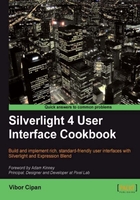
This book offers a number of tutorial-based recipes with each recipe depicting one of the commonly used user interface patterns built with Silverlight (and in some cases with WPF just to showcase the possibilities). Each recipe takes a step-by-step approach, first giving you the idea what is the recipe about, followed by the steps needed to be executed. The chapter then explains about the recipe, context for its usage and, last but not the least, the professional user interface and user experience guidelines.
From discussion and recipes dealing with fixed and fluid layouts, sample data generation, and building the custom command link controls, to the more advanced and somewhat avant-garde topics covering the usage and implementation of webcam and printing support and pixel shader effects this book is covering all you need to know to properly design and implement your user interface together with professional user experience and interface guidelines to make your solutions and apps pleasurable for your users.
Chapter 1, Layouts and General Content Organization gives you an introduction to the different ways of content and interface organization. Not only covering the topics of when to use fixed and fluid layouts, but also content organization with tabs and other available controls, this chapter is fundamental in many aspects.
Chapter 2, Actions and Commands gives you recipes and patterns involving regular buttons, progress bars, and list boxes. It covers ground touching many different patterns for bringing your UI to life and keeping your users happy and informed. You can also learn how to build your own custom control and expose its properties.
Chapter 3, Searching, Finding, and Navigating teaches you how to architect your application's UI. By introducing you to the concepts of faceted navigation, prominent action points, titled sections, it gives you a precise guide on how and when to use specific Silverlight controls to build your desired UI.
Chapter 4, Date and Time Input, Tables, and Ratings will show you how to use form elements to build usable and flexible date, time and calendar interfaces. Special attention is given to the globalization and related guidelines. Also, this recipe covers dealing with long lists it will show you how real-life metaphors are used in modern UIs.
Chapter 5, Maps, Pop-up Windows and Escaping the Browser showcases some of the more modern UI patterns possible with Silverlight. It also covers fundamental but often overlooked pattern called progressive disclosure. Looking at adding mapping capabilities to your application or to run and use your Silverlight application out of the browser? Those patterns are covered in this chapter.
Chapter 6, New Controls and Avant-garde Features will show you how to use some of the coolest new Silverlight features. For example, PathListBox enables you to abandon classical, rectangular appearance of the ListBox container, while pixel shaders and effects can add some extra fun to your applications. Now add support for webcam and printing and you'll be able to build really rich and immersive experiences with Silverlight.